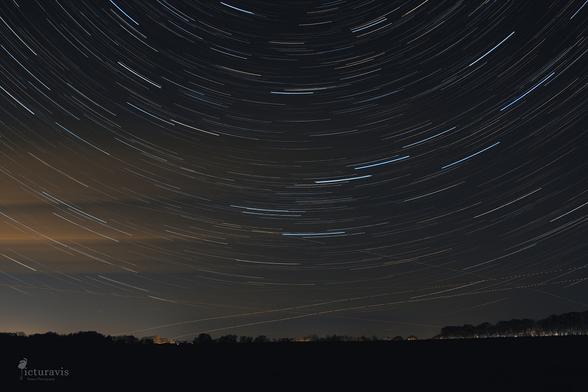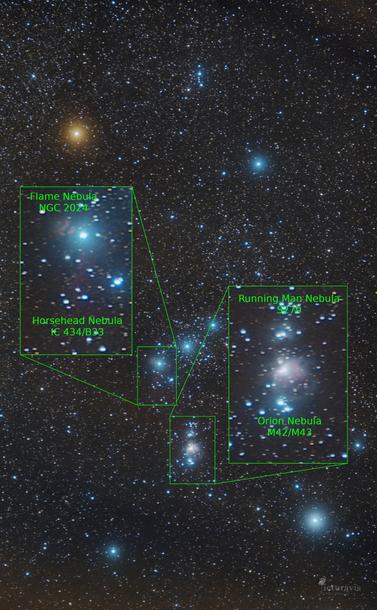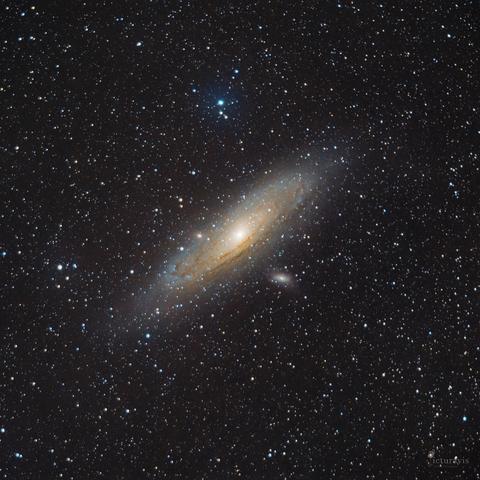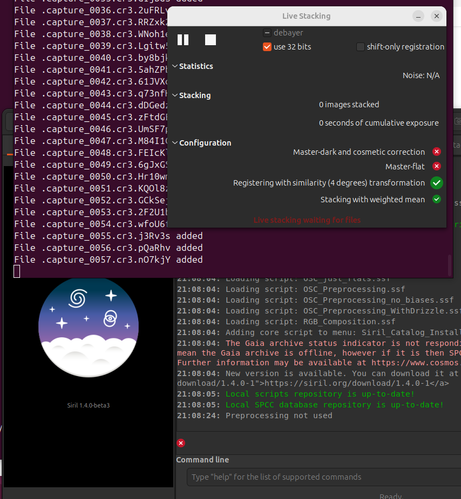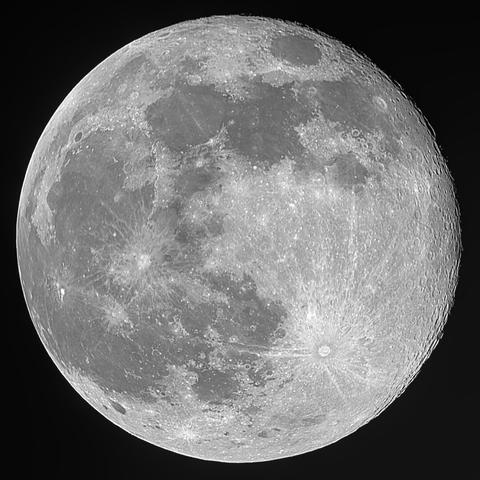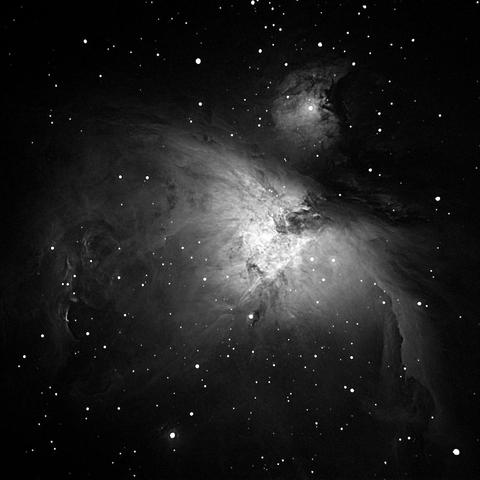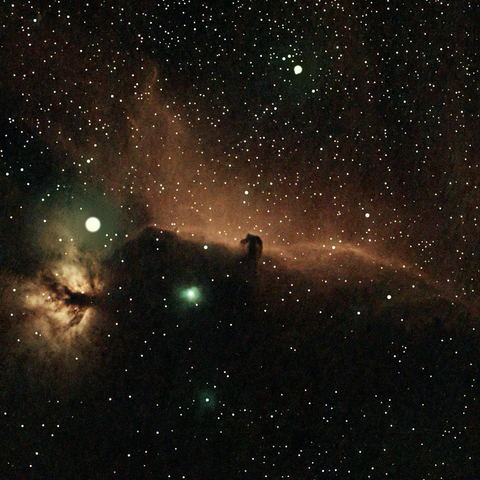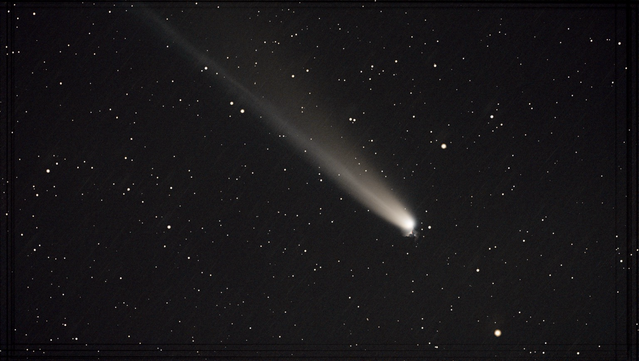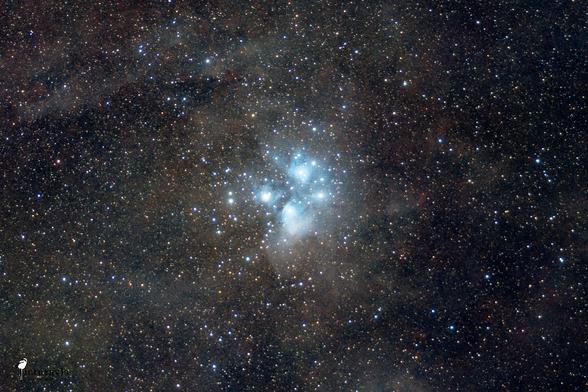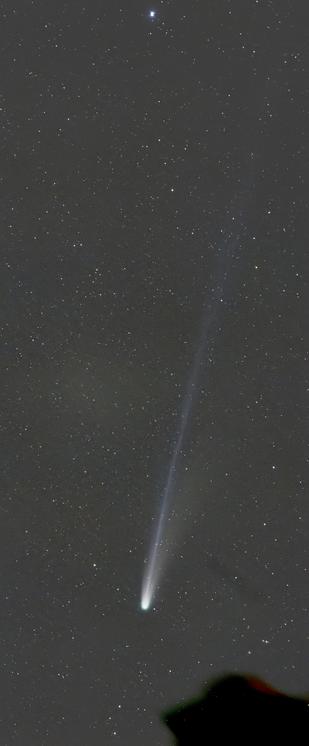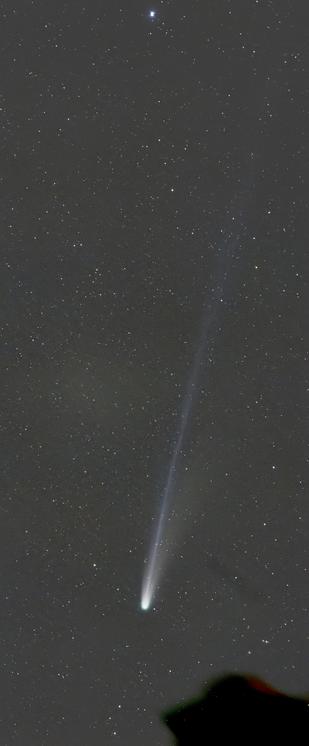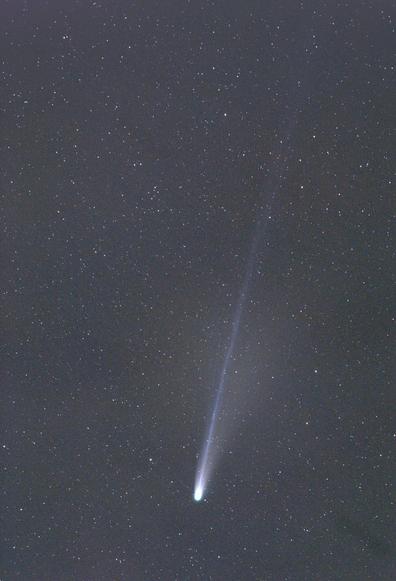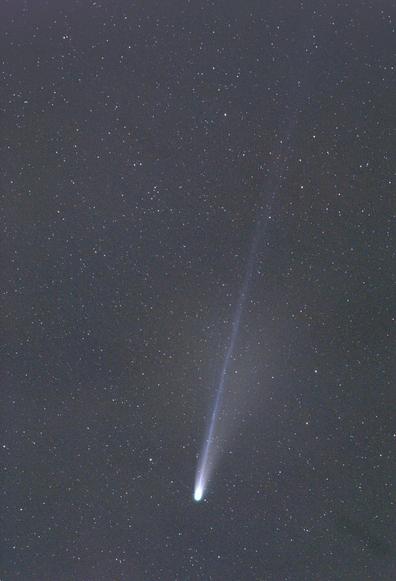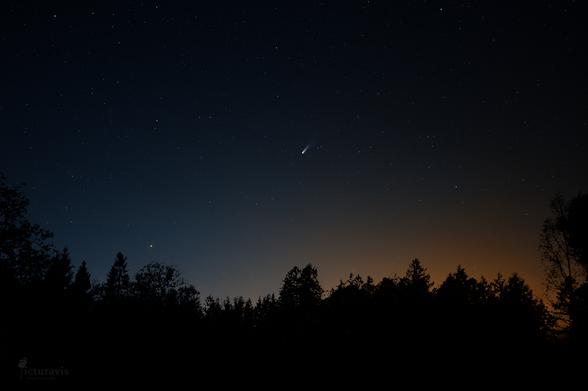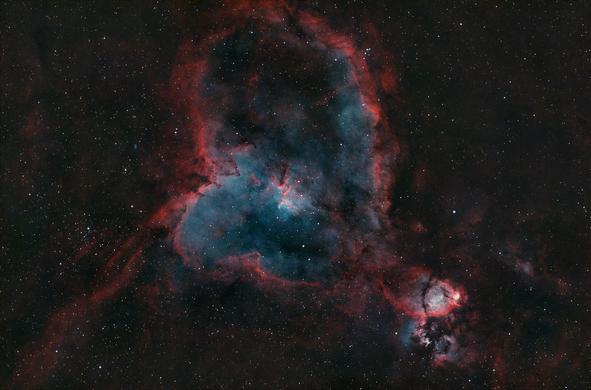#siril
What do you do with a lot of photos with no or very faint aurora? Star trails!
Created from 219 photos spanning 40 minutes via maximum pixel-value stacking in #Siril, with final touches in #GIMP.
Nikon Z50, Nikkor 17-28/2.8, 17 mm, f/2.8, 219×10 s, ISO 1600, tripod
#StarTrails #stars #nightscape #photography #astrophotography #SilentSunday #digikam
Orion photographed under suboptimal conditions. It was relatively low over the horizon, there was haze, thin clouds, and light pollution. But I like the glow it gave the bright stars. The Orion Nebula (M42 and M43), the Running Man Nebula (S279) the Flame Nebula (NGC 2024) and the Horsehead Nebula (B33 and IC 434) are visible. Especially the latter surprised me, although there is just a long red blob with a small black blob visible.
I chose too long an exposure time for pixel peeping, so please ignore the oblong stars.
Image created from 99x10s exposures (16 minutes, 30 seconds) with #Siril, #GraXpert and #GIMP.
Nikon Z50, Nikkor 17-28/2.8, 28 mm, f/2.8, 99×10 s, ISO 3200, tripod, no tracker
#constellation #orion #nebulae #stars #photography #astrophotography #digikam
I went outside for the Aurora party, and all I got was this lousy Andromeda Galaxy.
Since I was a day late for the aurora, but the sky was relatively clear, I decided to try the Andromeda Galaxy (M31) again, this time with more integration time. This was in a Bortle class 4–5 area with occasional thin clouds (you can see the shine around the bright stars), but at least the moon rose late. It (again) worked out better than expected. M32 and M110 are clearly visible, and even finer details and colors of the galaxy can be seen.
This time, I used 868 frames with a total exposure time of 28 minutes and 56 seconds, with sporadic manual tracking. The FITS sequence file of the registered images was over 200 GB… and the standard processing script failed, because today I learned 400 GB is apparently not enough free space for processing astro images.
Post-processing was done in #Siril with #GraXpert and #StarNet, and then #GIMP including #GMIC. The annotation in the second image was also done in Siril.
Without a tracker, the larger field of view of the 158 mm (effective) lens is good, as I did not have to adjust the camera as often. But the need to crop out less-exposed outer areas reduces the available final resolution. Additionally, the maximum limit of 2 s exposures (any more and the Earth rotates too fast) requires many images (and data).
Nikon D500, Sigma 105mm EX DG OS HSM, 105 mm, f/2.8, 868x2 s, ISO 3200, tripod, no tracker
#Andromeda #Galaxy #astrophotography #photography #germany #digikam
Hey #astrophotography , I'm trying #Siril live-stacking function and... It doesn't work at all. The log in the terminal is telling me it's seeing/adding the new pictures, but the GUI does nothing... any idea?
Las Nebulosas del Velo Occidental y Oriental son las más prominentes del llamado Bucle de Cisne, que es un conjunto de nebulosas casi todas restos de supernovas.
Son nubes de gas y polvo calentadas, que muestran estructuras filamentosas e intrincadas, modeladas por las ondas de choque en expansión.
Suele ser necesario el uso de filtro OIII para su observación.
48 tomas de 300s con filtro HaO3, FRA400 y ASI2600MC
#siril #astrofotografia
In meiner Kindheit faszinierte mich das Foto des Pferdekopfnebels in einem „Was ist Was“ Buch. Jetzt konnte ich ihn das erste Mal selbst aufnehmen. Trotz 98% Mond, Dunst und leichten Wolken.
Von knapp 500 Aufnahmen je 60s konnte ich nur 112 gebrauchen - aber ich werde noch mehr Aufnahmen machen und bin dann auch feinfühliger bei der Nachbearbeitung in #siril und #graxpert
#astronomy #astrophotography #dwarf3
Heute hatte ich dann doch unerwartet das Glück, dass ich nach Sonnenuntergang auf Kometenjagd gehen konnte. Also auf zum Wichtelesberg bei #donauwoerth
C 2025 A6 Lemmon, 64 Einzelbilder mit je 30s, nachbearbeitet in #siril
Das 2. Bild zeigt meinen #dwarf3 mit Lemmon im Hintergrund (Suchbild)
Ruins of the ancient cretan city of Itanos ( Ίτανος) in front of the Milky Way.
This is a second attempt at photos taken in 2022.
The Milky Way was photographed with an integration time of 38 x 8s = 5m 4s and processed with #Siril, #GraXpert, #StarNet and #GIMP. The ruins were taken with 30s exposure and light painted with a flashlight, then processed with #RawTherapee and GIMP. Final composition was done in GIMP.
Milky Way: Nikon D500, Tokina AT-X 11-20 f2.8 PRO DX, 11 mm, f2.8, 38x8s, ISO 3200, tripod
Ruins: Nikon D500, Tokina AT-X 11-20 f2.8 PRO DX, 11 mm, f2.8, 30s, ISO 800, tripod, light painted
#astrophotography #ruins #nightscape #milkyway #photography #greece
This is a second attempt at post-processing the Pleiades star cluster (M45). This time, I took more time to learn #Siril and added #GraXpert for background extraction and denoising.
The data are the same as in the previous attempt, so you can see how important post-processing is in astrophotography. Fine details are not visible, as the data do not contain enough information, but to my taste, this version is much improved.
I am still very impressed with what is achievable with a standard DSLR, a fast lens, and a standard tripod.
Nikon D500, Sigma 105mm EX DG OS HSM, 105 mm, f/2.8, 177x2 s, ISO 3200, tripod
#pleiades #astrophotography #photography #germany #digiKam #StarNet #GIMP
Comet C/2025 A6 (Lemmon) (bottom of the image) and Gemma (main star in the constellation Corona Borealis) (top of the image) on 24 October at 20:33 CEST from Wedemark, north of Hanover, Germany.
The straight, bluish plasma tail is visible over a length of ~6° (12 full moon diameters). The curved dust tail is a lot shorter.
Crop from a stack of 51 2-second images at ISO 5000, f/2.8, and f=200 mm.
#CometLemmon #Comet #Astrophotography #Astronomy #Photography #Siril #Gimp
Komet C/2025 A6 (Lemmon) (unten) und Gemma (Hauptstern im Sternbild nördliche Krone) (oben) am 24. Oktober um 20:33 Uhr MESZ aus der Wedemark nördlich von Hannover.
Der gerade. bläuliche Plasmaschweif ist über eine Länge von rund 6° (12 Vollmonddurchmesser) erkennbar. Der gebogene Staubschweif ist deutlich kürzer.
Crop aus Stack von 51 Bildern mit 2 s Belichtungszeit bei ISO 5000, f/2,8 und und f=200 mm.
#KometLemmon #Komet #Astrofotografie #Astronomie #Fotografie #Siril #Gimp
Comet C/2025 A6 (Lemmon) on 24 Oktober at 20:28 CEST from Wedemark north of Hannover, Germany.
Cropped from a stack of 51 single exposures of 2 s at ISO 5000, f/2.8, and at f=200 mm.
Used Siril, Gimp, and NeatImage to improve stacked image afterwards.
Edit: Added newly edited version of the image with less color shift added.
Komet C/2025 A6 (Lemmon) am 24. Oktober um 20:28 Uhr MESZ aus der Wedemark nördlich von Hannover.
Crop aus Stack von 51 Bildern mit 2 s Belichtungszeit bei ISO 5000, f/2,8 und f=200 mm.
(Starke) Bearbeitung des Stacks mit Siril, Gimp und NeatImage.
Edit: Neu bearbeitete Version des Bildes mit weniger Farbstich hinzugefügt.
The conditions on Sunday (19.10.2025) were good, so I drove out to photograph the comet C/2025 A6 Lemmon. It was only visible in the camera and not to the naked eye.
This image is a composite of the comet, stars, background without stars, and the foreground. Except for the foreground, the image was created from 171 frames (14 minutes and 15 seconds of exposure) using #Siril, including #StarNet. Post-processing and final composition were done in #GIMP.
Nikon Z50, Nikkor 17-28/2.8, 28 mm, f/2.8, 171×5 s, ISO 1600, tripod
#comet #lemmon #astrophotography #photography #nightscape #germany #digikam
Nebulosas de emisión Corazón y Cabeza de Pez. Constelación de Cassiopeia.
Se componen de brillantes gases ionizados de hidrógeno, oxígeno y azufre, en medio de zonas de polvo más oscuros.
La radiación energética y los vientos de las estrellas jóvenes y calientes en su núcleo iluminan el gas, dando a la nebulosa Corazón su tono rojizo similar a un corazón humano.
9h de exposición: tomas de 300sg, 24 con OSC , 40 con S2O3 y 48 con HaO3.
FRA400, ASI2600MC
Procesada con #siril
#astrofotografia
This image of the Andromeda Galaxy (M31) was not planned. I saw M31 on the Stellarium app while outside for Comet Lemmon and thought, why not? I took a few photos but gave up early because I thought my equipment would not be enough to get any details. Turns out I was wrong, and you can get details even with a 105 mm f/2.8 macro lens on a crop-sensor DSLR.
This was just 23 photos, resulting in 46 seconds of exposure. Post-processing was done in #Siril with #StarNet, followed by #GIMP and #Darktable. Next time, I’ll know better!
Nikon D500, Sigma 105mm EX DG OS HSM, 105 mm, f/2.8, 2 s, ISO 3200, tripod
#Andromeda #Galaxy #astrophotography #photography #germany
